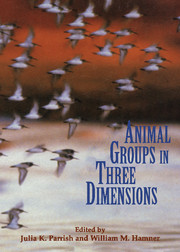Book contents
- Frontmatter
- Contents
- List of contributors
- Acknowledgments
- 1 Introduction – From individuals to aggregations: Unifying properties, global framework, and the holy grails of congregation
- Part one Imaging and measurement
- Part two Analysis
- Part three Behavioral ecology and evolution
- Part four Models
- 16 Conceptual and methodological issues in the modeling of biological aggregations
- 17 Schooling as a strategy for taxis in a noisy environment
- 18 Trail following as an adaptable mechanism for popular behavior
- 19 Metabolic models of fish school behavior – the need for quantitative observations
- 20 Social forces in animal congregations: Interactive, motivational, and sensory aspects
- References
- Subject index
- Taxonomic index
16 - Conceptual and methodological issues in the modeling of biological aggregations
from Part four - Models
Published online by Cambridge University Press: 01 June 2010
- Frontmatter
- Contents
- List of contributors
- Acknowledgments
- 1 Introduction – From individuals to aggregations: Unifying properties, global framework, and the holy grails of congregation
- Part one Imaging and measurement
- Part two Analysis
- Part three Behavioral ecology and evolution
- Part four Models
- 16 Conceptual and methodological issues in the modeling of biological aggregations
- 17 Schooling as a strategy for taxis in a noisy environment
- 18 Trail following as an adaptable mechanism for popular behavior
- 19 Metabolic models of fish school behavior – the need for quantitative observations
- 20 Social forces in animal congregations: Interactive, motivational, and sensory aspects
- References
- Subject index
- Taxonomic index
Summary
Introduction
In the past two decades, there has been a growing recognition in ecology of the problem of scale. This generalization is especially true in the study of schooling, herding, and swarming, in which there is an inherent duality in scale between individual behavior and group and population level dynamics. Steele and others (Steele 1978 Haury et al. 1978 Levin 1992) have pointed out that our measurements and perceptions of pattern are conditioned by the perspectives we impose through our scales of description. At any scale of resolution, we average dynamics that take place on faster scales the strategy is analogous to that used by other organisms in their evolutionary responses to variability. Indeed, it is clear that not every fine-scale detail is relevant to understanding phenomena on broader scales and that inclusion of unnecessary detail only obfuscates understanding of the mechanisms underlying patterns of interest. The central problem is to determine how information is transferred across scales and exactly what detail at fine scales is necessary and sufficient for understanding pattern on averaged scales.
The problem of how information is transferred across scales cannot be addressed without modeling. In relating behaviors on one scale to those on others, one is often dealing with processes operating on radically different time scales, in which much of the detail on faster or finer scales must be irrelevant to those on slower or broader scales. Because decisions about what one can ignore require a quantitative evaluation of the manifestation of processes across scales, a quantitative approach is both unavoidable and powerful.
- Type
- Chapter
- Information
- Animal Groups in Three DimensionsHow Species Aggregate, pp. 247 - 256Publisher: Cambridge University PressPrint publication year: 1997
- 2
- Cited by



